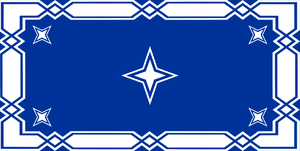Valosian Coscivians
| Valosians Valōsŏm | |
|---|---|
 | |
| Type | Ethno-nationality |
| Population | 22 million |
| Cohort | Costratic |
| Language | Valosian Coscivian |
| Religion | Coscivian Orthodoxy |
| Leader | King of the Valosians |
| Endogamous? | Yes |
| IDO Status | Midstream |
| Colour | Royal blue |
| Distribution | |
| Diaspora | Avidrona, Fariva, Xula, Serikorda, Montitoba Territory |
Valosian Coscivians, or simply Valosians, are a Costratic Coscivian ethnic group whose historic homeland was Kórsa, particularly the [southeast part of it]. The Valosians ruled over most of Kórsa before being displaced as the country´s élite by the Vexin Coscivians , and then again after their ouster of the Vexins from most of the country.
Valosians are an extremely socially cohesive ethnic group, due in part to their intense pride in their language, heritage, and traditions, and perhaps also in large part to their abject disdain for many of the other peoples of Kiravia.
Valosians have their own customary ruler, the King of the Valosians, who reigns as a hereditary non-territorial ethnarch with an important ceremonial role and close involvement in the operation of various Valosian cultural, educational, and charitable institutions. The current King is Rando the Fatass, whose (rather copious) seat is in [Place], [State]. The Valosian King pays regular tribute to the Marble Emperor.
Culture
The Valosians have their own language, Valosian Coscivian, which is descended from General Costratic. They use both their own language and High Coscivian (usually in its Orthodox or Traditional register) as literary languages, and both are taught rigorously in Valosian private schools. According to the 21200 Kiravian Census, 86% of households with two Valosian parents spoke Valosian Coscivian at home, a much higher retention rate than most major Coscivian ethnic vernaculars.
Valosians are devout Coscivian Orthodox Christians, though they keep certain Rurican traditions.
Ethnic Rivalries
Valosians are famous for their capacity to sustain centuries-old historic grudges against other ethnic groups. Their most intense hatred is reserved for the Vexin Coscivians and the Eshavian Coscivians, though they have come to also strongly dislike the Kir and just about anyone else they encounter. Valosians are dismissive of and resentful towards Paisonic Coscivians, as Valosians consider themselves to be the true heirs to the ruling class and traditions of Imperial Coscivia. However, they do share close cultural ties with certain Peninsular subgroups and a common Coscivian Orthodox faith.
The Federal Civil Rights Commission regularly receives and investigates reports of governmental and commercial discrimination against Valosian Coscivians in the historically Vexin-dominated states of Hanoram and Province №7.
Relations are much friendlier with the related Kostiatem, Ardóniem, and Purgóniem.
Politics
Most Valosian Coscivians are of a traditionalist orientation and long for the restoration of historic Coscivian political institutions and ways of life dating from periods when their people were most influential. When voting, they typically support parties affiliated with the Authentic Historical Caucus, which includes several state-level Valosian minority interest parties. Many Valosians are involved in the Kiravian Monarchist Party.
Valosian militia fought fiercely against the Orange Brigades during the Colour Wars, and many were involved in the traditionalist wing of the anti-Kirsok resistence during Kirosocialism.
Populations
Valosian communities can be found in several regions of Kiravia, with the largest in Xula (whole ‘nother story about the Xulan ones), Kaviska, Elegia, Avidrona, [the state between Elegia and Avidrona], and Kernea, with smaller populations in Issyria (both “Issyrian Valosians” and Xulans) and Devahoma, with some scattered communities in the Northwest. Although comparatively small in absolute numbers, the Valosian community is one of the largest Coscivian groups in the small state of Serikorda.
There is also a significant Valosian community in Fariva, concentrated almost entirely in Bérasar and its inner metropolitan area.